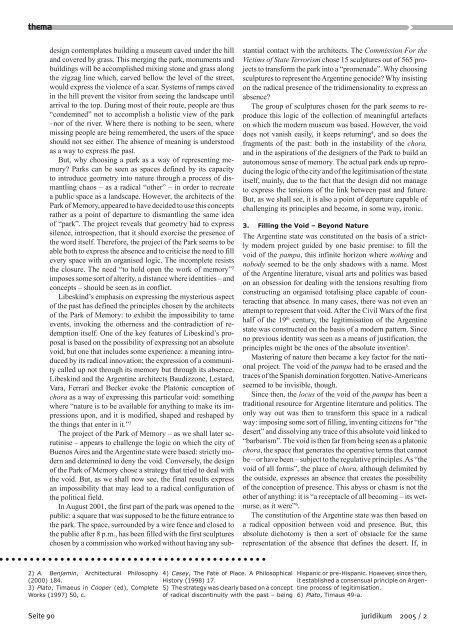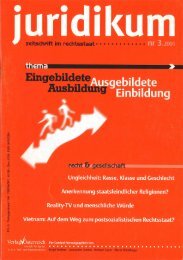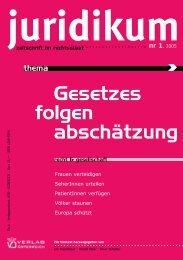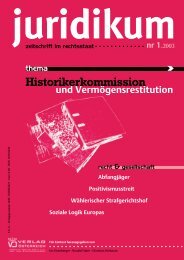Thema Transitional Justice - juridikum, zeitschrift für kritik | recht ...
Thema Transitional Justice - juridikum, zeitschrift für kritik | recht ...
Thema Transitional Justice - juridikum, zeitschrift für kritik | recht ...
Erfolgreiche ePaper selbst erstellen
Machen Sie aus Ihren PDF Publikationen ein blätterbares Flipbook mit unserer einzigartigen Google optimierten e-Paper Software.
thema<br />
design contemplates building a museum caved under the hill<br />
and covered by grass. This merging the park, monuments and<br />
buildings will be accomplished mixing stone and grass along<br />
the zigzag line which, carved bellow the level of the street,<br />
would express the violence of a scar. Systems of ramps caved<br />
in the hill prevent the visitor from seeing the landscape until<br />
arrival to the top. During most of their route, people are thus<br />
“condemned” not to accomplish a holistic view of the park<br />
–nor of the river. Where there is nothing to be seen, where<br />
missing people are being remembered, the users of the space<br />
should not see either. The absence of meaning is understood<br />
as a way to express the past.<br />
But, why choosing a park as a way of representing memory?<br />
Parks can be seen as spaces defined by its capacity<br />
to introduce geometry into nature through a process of dismantling<br />
chaos – as a radical “other” – in order to recreate<br />
a public space as a landscape. However, the architects of the<br />
Park of Memory, appeared to have decided to use this concepts<br />
rather as a point of departure to dismantling the same idea<br />
of “park”. The project reveals that geometry had to express<br />
silence, introspection, that it should exorcise the presence of<br />
the word itself. Therefore, the project of the Park seems to be<br />
able both to express the absence and to criticise the need to fill<br />
every space with an organised logic. The incomplete resists<br />
the closure. The need “to hold open the work of memory” 2<br />
imposes some sort of alterity, a distance where identities – and<br />
concepts – should be seen as in conflict.<br />
Libeskind’s emphasis on expressing the mysterious aspect<br />
of the past has defined the principles chosen by the architects<br />
of the Park of Memory: to exhibit the impossibility to tame<br />
events, invoking the otherness and the contradiction of redemption<br />
itself. One of the key features of Libeskind’s proposal<br />
is based on the possibility of expressing not an absolute<br />
void, but one that includes some experience: a meaning introduced<br />
by its radical innovation; the expression of a community<br />
called up not through its memory but through its absence.<br />
Libeskind and the Argentine architects Baudizzone, Lestard,<br />
Vara, Ferrari and Becker evoke the Platonic conception of<br />
chora as a way of expressing this particular void: something<br />
where “nature is to be available for anything to make its impressions<br />
upon, and it is modified, shaped and reshaped by<br />
the things that enter in it.” 3<br />
The project of the Park of Memory – as we shall later scrutinise<br />
– appears to challenge the logic on which the city of<br />
Buenos Aires and the Argentine state were based: strictly modern<br />
and determined to deny the void. Conversely, the design<br />
of the Park of Memory chose a strategy that tried to deal with<br />
the void. But, as we shall now see, the final results express<br />
an impossibility that may lead to a radical configuration of<br />
the political field.<br />
In August 2001, the first part of the park was opened to the<br />
public: a square that was supposed to be the future entrance to<br />
the park. The space, surrounded by a wire fence and closed to<br />
the public after 8 p.m., has been filled with the first sculptures<br />
chosen by a commission who worked without having any substantial<br />
contact with the architects. The Commission For the<br />
Victims of State Terrorism chose 15 sculptures out of 565 projects<br />
to transform the park into a “promenade”. Why choosing<br />
sculptures to represent the Argentine genocide? Why insisting<br />
on the radical presence of the tridimensionality to express an<br />
absence?<br />
The group of sculptures chosen for the park seems to reproduce<br />
this logic of the collection of meaningful artefacts<br />
on which the modern museum was based. However, the void<br />
does not vanish easily, it keeps returning 4 , and so does the<br />
fragments of the past: both in the instability of the chora,<br />
and in the aspirations of the designers of the Park to build an<br />
autonomous sense of memory. The actual park ends up reproducing<br />
the logic of the city and of the legitimisation of the state<br />
itself, mainly, due to the fact that the design did not manage<br />
to express the tensions of the link between past and future.<br />
But, as we shall see, it is also a point of departure capable of<br />
challenging its principles and become, in some way, ironic.<br />
3. Filling the Void – Beyond Nature<br />
The Argentine state was constituted on the basis of a strictly<br />
modern project guided by one basic premise: to fill the<br />
void of the pampa, this infinite horizon where nothing and<br />
nobody seemed to be the only shadows with a name. Most<br />
of the Argentine literature, visual arts and politics was based<br />
on an obsession for dealing with the tensions resulting from<br />
constructing an organised totalising place capable of counteracting<br />
that absence. In many cases, there was not even an<br />
attempt to represent that void. After the Civil Wars of the first<br />
half of the 19 th century, the legitimisation of the Argentine<br />
state was constructed on the basis of a modern pattern. Since<br />
no previous identity was seen as a means of justification, the<br />
principles might be the ones of the absolute invention 5 .<br />
Mastering of nature then became a key factor for the national<br />
project. The void of the pampa had to be erased and the<br />
traces of the Spanish domination forgotten. Native-Americans<br />
seemed to be invisible, though.<br />
Since then, the locus of the void of the pampa has been a<br />
traditional resource for Argentine literature and politics. The<br />
only way out was then to transform this space in a radical<br />
way: imposing some sort of filling, inventing citizens for “the<br />
desert” and dissolving any trace of this absolute void linked to<br />
“barbarism”. The void is then far from being seen as a platonic<br />
chora, the space that generates the operative terms that cannot<br />
be – or have been – subject to the regulative principles. As “the<br />
void of all forms”, the place of chora, although delimited by<br />
the outside, expresses an absence that creates the possibility<br />
of the conception of presence. This abyss or chasm is not the<br />
other of anything: it is “a receptacle of all becoming – its wetnurse,<br />
as it were” 6 .<br />
The constitution of the Argentine state was then based on<br />
a radical opposition between void and presence. But, this<br />
absolute dichotomy is then a sort of obstacle for the same<br />
representation of the absence that defines the desert. If, in<br />
2) A. Benjamin, Architectural Philosophy<br />
(2000) 184.<br />
3) Plato, Timaeus in Cooper (ed), Complete<br />
Works (1997) 50, c.<br />
4) Casey, The Fate of Place. A Philosophical<br />
History (1998) 17.<br />
5) The strategy was clearly based on a concept<br />
of radical discontinuity with the past – being<br />
Hispanic or pre-Hispanic. However, since then,<br />
it established a consensual principle on Argentine<br />
process of legitimisation.<br />
6) Plato, Timaus 49-a.<br />
Seite 90 <strong>juridikum</strong> 2005 / 2
















